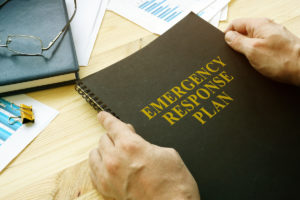
Senior living communities are among the best places for older adults of all levels of independence and abilities to be—offering professional care, daily stimulation, nourishing dining, and more.
At Franklin Park® Senior Living, our senior living communities are dedicated to prioritizing the health, wellness, and safety of all our residents—whether it’s in the case of a chronic health condition, a global pandemic, or a natural disaster.
Our senior living communities throughout San Antonio, Texas, are often impacted by hurricane season, which runs from June 1 – November 30. We wanted to take an opportunity to highlight the emergency preparedness and procedures we have in place for inclement weather, as well as other scenarios that could impact our communities.
Basic Safety Features
As is necessary for all senior living communities, each Franklin Park® community conducts a risk-analysis assessment that fits our specific building locations and level of care provided.
In today’s modern structures, NFPA (National Fire Protection Association) building codes ensure that buildings are designed to slow or mitigate the risk residents and staff may face when it comes to fires and other emergencies. Safety features that allow this include automatic sprinkler systems, fire partitions, alarms, and multiple evacuation routes, as well as structural integrity and areas of refuge.
In addition to preparing for indoor emergencies and events that could directly impact our communities, it is also vital to assess outside risks. We inspect each of our communities and the surrounding areas to ensure that we are prepared for any of the following external hazards that could impact our infrastructure:
- Closeby Hazardous Chemicals Route
- Railway Line or Crossing
- Natural Gas Pipeline
- Roads Leading to Our Community That Could Be Impacted by Landslides or Polluted Water
- Nearby Buildings That Could Spread Fires
- Weather Extremes That May Impact The San Antonio Area, Such as Seasonal Tornadic Activity, Flash Floods or Hurricanes, and Wildfires.
Written Disaster Plans
In the rare case of an evacuation, all Franklin Park® communities have evacuation protocols in place for various emergencies, called a written disaster plan. Depending on the type of community and level of care provided, Texas law requires that each written disaster plan include the following:
- Direction and Control: Analyzing information about an impending disaster, deciding how to respond quickly and appropriately, and directing and coordinating the response of staff.
- Warning: Developing a procedure and method for quickly notifying staff, residents, and families.
- Communication: Maintain and test current communication methods, including fire alarm systems, connections to the local fire department, and other ways of contacting first responders, families, and off-duty staff. We also ensure we have back-up methods of communication should our regular means be disrupted.
- Sheltering Arrangements: Making the decision whether to shelter-in-place or fully evacuate. We also consider those with mobility issues and offer an area of refuge inside the facility for them, if possible.
- Evacuation: Identifying evacuation sites, including back-up sites and alternate routes.
- Transportation: Considering what types of vehicles will be used for evacuation and assuring that the emergency vehicles meet the needs of all residents.
- Health and Medical Needs: Managing and mobilizing health and medical services, determining which types of equipment and medication should be brought on evacuations, and ensuring everyone’s general safety and health.
- Identification of Residents: Planning how to organize and keep medical records and medication lists with the proper resident while still following HIPAA procedures and ensuring that each resident and staff member is accounted for.
Handling Power Outages
Usually, power outages are brief and not significantly threatening, but they can become dangerous for those who rely on powered equipment. Texas law requires that nursing homes have generators and emergency power systems. However, most communities with generators do not power the whole building. Because of this, families and physicians must communicate a resident’s specific level of need before they are moved to a certain location in the community.
Preparing Residents
In each of our communities, we prepare and practice emergency evacuations and rehearse preparedness with our residents. We believe it is best practice to assess and prioritize the emergencies most likely to occur and then plan, practice, and prepare.
Franklin Park® Senior Living believes that emergency planning and readiness should always be an ongoing process, including every member of the staff and residents (when appropriate). In fact, in higher levels of care, certain types of drills and planning are mandatory.
Special Procedures for Memory Care Residents
Franklin Park’s memory care neighborhoods are unique in how we handle emergencies. Alarms can be startling, and an evacuation of a building may not be the best course of action. Our memory care communities have the ability to shelter in place and keep residents inside an area of refuge and out of the elements.
Dedicated to Health and Safety
At Franklin Park® Senior Living, we want residents to experience resort-style retirement living, knowing they are safe from disaster and emergency. We assure every staff member is thoroughly trained, prepared, and empowered to respond to an emergency or disaster situation, prioritizing the safety and well-being of residents and guests. By preparing, communicating, and collaborating, we can effectively and quickly respond to anything that comes our way.
Franklin Park® Senior Living offers independent living, assisted living, and memory care services throughout San Antonio, Texas. If you have any questions about the emergency preparedness and response in our senior living communities, we invite you to contact our team today.
